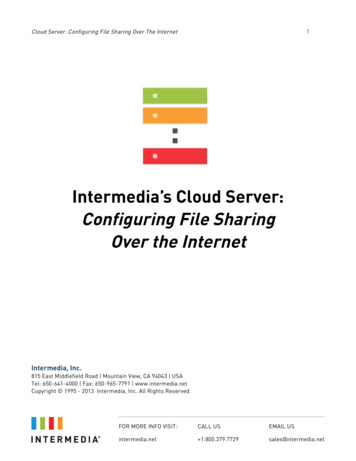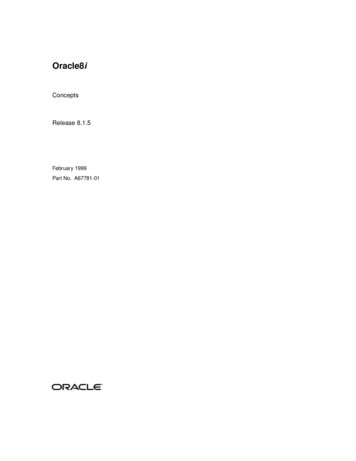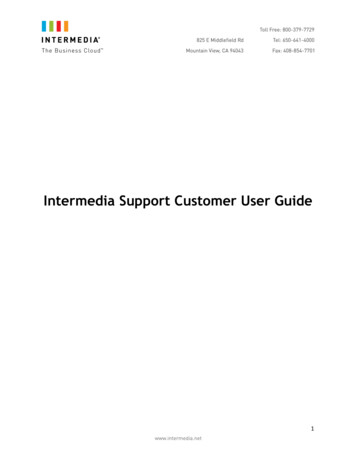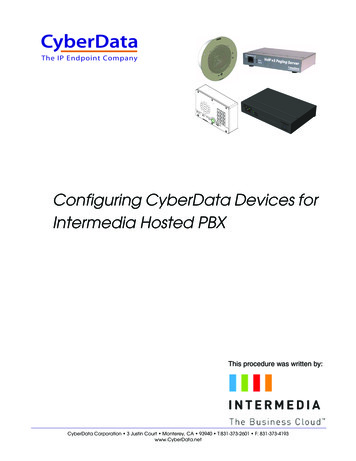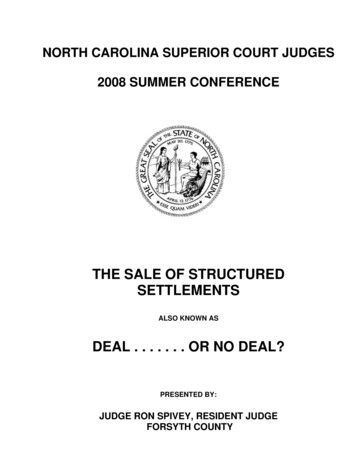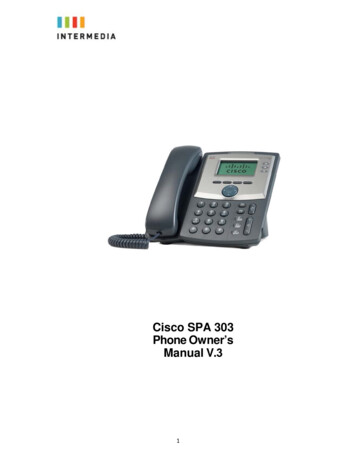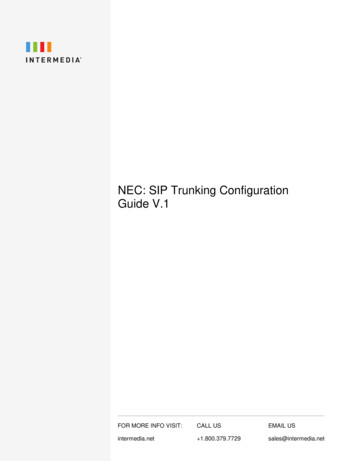
Transcription
ORACLE8i INTERMEDIA:MANAGE STRUCTURED AND UNSTRUCTURED DATAFOR FAST AND ACCURATE RETRIEVALByLin SunA master’s paper submitted to the facultyof the School of Information and Library Scienceof the University of North Carolina at Chapel Hillin partial fulfillment of the requirementsfor the degree of Master of Science inInformation ScienceChapel Hill, North CarolinaApril, 2001Approved by:Advisor
Lin Sun. Oracle8i interMedia: Manage Structured and Unstructured Data For Fast andAccurate Retrieval. A Master’s paper for the M.S. in I.S. degree. April, 2001. 76 pages.Advisor: Gary MarchioniniThis paper describes a novel design and implementation of manipulating structured andunstructured data in the Oracle8i database over the web interface using Java ServerPages. A text recognition script is developed to automate the process of piping data fromtext formats into the various table fields into the Oracle 8i database. Familiar InternetExplorer 5.0 or above and Netscape 4.7 or above are supported to run the web interfaceand perform Boolean and some other advanced search over the Oracle8i database.A three-tier architecture is used in the web database design. An Oracle8i database storesraw data in the tablespaces. The JSP server generates the response by querying theOracle8i database and provides the web server with data in standard HTML formats. Theclient side tier (web browser) inputs the query and requests the response from the webserver.Headings:Data Piping Method – Text Recognition ScriptSystem Structure – Three-Tier Architecture DesignUnstructured Data – Oracle8i interMedia
ITable of ContentsSessionPageChapter 1: Introduction and Statement of the Problem11) Introduction12) Background3Chapter 2: Statement of the Problem5Chapter 3: Literature review71) Information Retrieval Overview72) Backend--Oracle8i Database83) Front end--Java Server Pages9Chapter 4. System Analysis and Design111) System Analysis112) Database Design13 Database Schema Design13 Data Dictionary153) Data Piping Design214) Web Database Architecture Design24Chapter 5. Implementation and Results1) Oracle8i interMedia Implementation Create Index262626
II CONTAINS Function282) Java Server Pages Implementation353) System Prototype Results36Chapter 6. Conclusions and Recommendations381) Conclusions382) Recommendations38Bibliography40Appendix A:42 Sample Patent42 SQL generator44Appendix B:66 Java Server Pages Web Interface66 JSP: Keyword Search68 JSP: Exact Search7
1Chapter 1: Introduction1. Introduction:Oracle8, which is a traditional database management system, provides a variety of datatypes you can use to create database applications that take advantage of structured dataand unstructured data. Besides some general data types like date, string, number, andboolean for structured data, Oracle8 has several large object (LOB) data types likecharacter LOB (CLOB), and binary LOB (BLOB) to support applications that mustmanage large unstructured objects as well as binary file (BFILE), which stores LOBlocators.Oracle8i is built on Oracle8, and it is known as the database for Internet computing. Itchanges the way that information is managed and accessed to meet the current highdemand of Internet data transportation and retrieval. It provides significant new featuresfor traditional online transaction processing and data communications between more thanone databases compared with Oracle8. It provides many advanced new tools likeinterMedia, WebDB and so on to help users successfully manage all types of data storedin an Oracle database and deliver the database content, including very Large Objects(LOB), to remote users’ client machines with high performance, scalability and security.
2In the past ten years people have invested very heavily in building applications thatenable us to rapidly retrieve structured data, which is stored in columns in the database.However, in Oracle8 a beginner’s guide, it points out that many studies state that 90percent of the world’s date is unstructured. It is not surprising to find out that almost allthe articles, web pages, e- mails, and other documentations are unstructured data. Howwonderful if we could be able to retrieve the results of users’ documentations based onusers’ queries!The Oracle8i Server interMedia allows businesses to manage and access multi- mediadata, including image, large text, audio, video, and spatial (locator) data. The key optionof interMedia that we will investigate in this paper is interMedia’s text managementsolution that enables you to manage unstructured text information resources as quickly asyou manage structured date. It allows your Oracle8i server to deal with unstructured data,allowing users to access the large quantity of the unstructured data. Oracle8i interMediais revised after Oracle8 Server Context option with more powerful functions included.Oracle Corporation announced, “Oracle8i is designed to access and manage all your datausing the style and infrastructure of the Internet. Oracle8i is the most complete andcomprehensive platform for building, deploying, and managing Internet and traditional
3applications. Oracle8i provides the lowest cost platform for developing and deployingapplications on the Internet.”2. BackgroundNorth Carolina’s top two public research universities have launched a unique educationalprogram to stimulate entrepreneurship by developing donated real- world technologies.This program is named the Carbon Dioxide Patent Assessment, Acquisition and TransferInitiative (PAATI). It combines entrepreneurship, law, business, information science,chemistry, and chemical engineering expertise to commercialize technologies donated tothe universities from U.S. corporations. The University of North Carolina at Chapel Hill(UNC-CH) and North Carolina State University (NCSU) launched PAATI in May of2000 to establish a portfolio of donated CO2-related patents. The Initiative represents thefirst proactive effort in academia to provide technology transfer and entrepreneurialtraining to students by involving them in the Business to University transfer ofintellectual property. PAATI brings together the engineering, chemistry, law, business,and information science expertise at both universities to identify desirable patents; todevelop donation proposals, and to form commercialization plans for donated technology,which may be bundled with university patents for licensing.Currently, the US Patent and Trademark Office (USPTO) has provided an official webdatabase for all US patents information, which can be reached at
4http://www.uspto.gov/patft/index.html. Besides, IBM has also built a nice patentsearchable website (http://www.patents.ibm.com) and Cartesian Products, Inc.’s website(http://www.getthepatent.com/ ) can deliver the complete multi-page USPTO, EPO, andWIPO (PCT) patent documents direct to your desktop. Why do we need to build anotherweb database if some other web databases are available to the public?Because none of these web databases has provided a satisfactory interface or searchresults to professional chemists. For example, USPTO only has limited advanced searchand doesn’t provide search within a search, graphics or science added value. None ofthese features are provided by Get The Patent, which requires an initial payment. Dialogcould provide search within a search, but it requires training and web access is notavailable.
5Chapter 2: Statement of the ProblemAlthough the United States Patent and Trademark Office and some other companies havealready built some web databases, which can provide full text search and Boolean searchfeatures, none of these systems fit the needs of those people who have specific interest inCO2 related patents. Users, especially those chemistry specialists, usually complainedabout the difficulty of finding the information they need. They would like to have a webaccessible carbon dioxide related database, which will provide the useful features likeadvanced search, search in a search, science value-added, business intelligence and befree of charge. It should be very reliable, user friendly, support graphics and make it easyto capture patents. For example, they would like to know who is the leader in the CO2field, what countries are very active in the carbon dioxide field, patentexpiration/donation information, and so on. They would also like to search on patents’full text files as well as patents’ specific information like claims. Furthermore, since usershave chemistry knowledge rather than information retrieval skill, they would like to havea friendly web interface that makes it easy to learn how to search the database remotely.Another problem associated with the carbon dioxide related patent informationmanagement system is that there exists more than 1600 patents now, and the number ofpatents are growing very year. The patents are in text format when downloaded from theDialog database, which means that neither can users search on a specific field like claim
6nor can users search on the full text before the text format data is piped into the databasein different data types. Furthermore, the database back-end should be very easy to extendor interoperate with other database management systems.Moreover, there are a couple of performance issued involved with the carbon dioxiderelated patent information management system. For example, besides a friendly userinterface, users request fast and accurate information retrieval and group users’customized interface if possible and three level of security (view only, write/update, andadministrate) to the database. The database interface should be password protected withusername and password determining security level and privilege. In the meanwhile, usersalso request retrieval words based on their occurrences ranking in the whole database orspecific fields like claim.All in all, how to provide fast, accurate and reliable retrieval for the structured andunstructured data in the database management system becomes a very important researchquestion in the PAATI program. The Oracle8i Standard Edition on a Unix Platform hasbeen proposed as the database backend for its wide ranges of data types support and itsability to access and manage all data using the style and infrastructure of the Internet.Java Server Page, which is a part of the Java T M family and enables rapid development ofweb-based applications, has been proposed as the web interface language for its platformindependence. After the JSP and Oracle8i server marry through Oracle JDBC (JavaDatabase Connectivity), a dynamic web database will be generated to allow users toview, query and update the database.
7Chapter 3. Literature review1. Information Retrieval OverviewInformation Retrieval is a very wide term, and I am only concerned with automatic data& document in the Oracle8i database retrieval system in this paper. Mr. David Blair(1984) has mentioned, “The computerized retrieval of documents or texts from largedatabases is an area of increasing concern for those who design or use informationmanagement systems.” The dramatic growth of emails and web documents will requiresupplicated information retrieval system, if users would like to query these documents.The design and implementation of large unstructured document retrieval have laggedbehind those of small structured data retrieval. Blair also pointed out that people usuallytreat the logic foundation and technology of large document retrieval and the structureddata retrieval system the same. However, he thinks they are significantly different “inhow the queries are answered, in the relationship between the formal system request anduser satisfaction, in the criterion for successful retrieval, and in the factors that influenceretrieval speed”.Basically, queries to the structured data are direct, the responses are relatively fast and theretrieval speeds are contingent on the physical searching speeds of the system. Also, the
8structured data retrieval will provide more response on relative or irrelative data, whichmeans it will usually retrieve only the relevant answers and the criteria of success iscorrectness. However, there is not a distinction between correct and incorrect for thelarge document retrieval. Large documents are generally retrieved with their relativescorings. The queries are indirect and the retrieval speed is more dependent on thenumber of logic decisions the user makes in the search.2. Backend--Oracle8i DatabaseCompared with all the database management systems available in the market, we thinkOracle database has great advantages over other database systems in reliability, platformindependence, and compatibility with most programming languages. Oracle8i is thenewest production product of Oracle Corporation, and it is available as Oracle8i StandardEdition, Oracle8i Enterprise Edition, and Oracle8i Personal Edition. Because the Schoolof Information and Library Science could obtain university license from OracleCorporation, we will use the Oracle8i standard edition for our projects. Currently,Oracle8i is running on a Solaris UNIX box called Topaz and interMedia is one of its keyoptions.Oracle8i interMedia content is stored in tablespaces on the Oracle Server. It could beimage, audio, video or documents and can be within the database, in flat files or behind aweb URL, but always catalogued by Oracle8i interMedia. Compared with Oracle8’sConText, Oracle8i interMedia’s text services are more tightly integrated with Oracle8i.
9There are no servers to start up, there is no query rewrite, and index creation is donethrough familiar SQL rather than through a custom PL/SQL interface.Oracle8i interMedia supports a wide range of data types, but in this paper we will focuson the varchar2 (4000) and CLOB data types. After using Oracle8i interMedia to indexthe different data types, we could provide diverse functions to the users using Oracle8i’sCONTAINS query, which can only appear in the where clause of a select statement andnever appears in the where clauses of insert, update, or delete. The CONTAINS functionprovides the following features: Exact matches of a word or phrase Exact matches of multiple words, using Boolean logic to combine searches Search based on how close words are to each other. “Fuzzy” matches of words3. Front end--Java Server PagesWith the appearance of web database technologies—Common Gateway Interface, ActiveServer Pages, Cold Fusion, Personal Home Pages and Java Server pages, web pages areno longer static, but could be dynamic with communication to a back-end databaseserver. Currently, websites are able to display and manipulate the information lying onthe database server.Among these five web database technologies, Java Server Pages is the newesttechnology. JSP, which is an extension of the Java TM Servlet technology, is praised by Sun
10Microsystems as “platform independence, enhanced performance, separation of logicfrom display, ease of administration, extensibility into the enterprise and mostimportantly, ease of use.”( http://java.sun.com/products/jsp/index.html, 2001). It allowsweb programmers/designers to easily develop and maintain the information-rich,dynamic webpages. It also separates the user interface from content generation, whichenables designers to change the overall page layout without altering the underlyingdynamic content and informing the web programmers.Java Server Pages (JSP) is very similar to Active Server Pages, but it is written in theJava programming language and inherits many advantages of Java TM like encapsulation,platform independence and hiding information. Most importantly, JSP logic could residein server-based reusable resources like JavaBeansTM . Sun Microsystems says, “Byseparating the page logic from its design and display and supporting a reusablecomponent-based design, JSP technology makes it faster and easier than ever to buildweb-based applications.” (http://java.sun.com/products/jsp/index.html, 2001).Another great advantage of JSP is that Sun Microsystems has made the JSP specificationfreely available to the development community. JSP pages share the "Write Once, RunAnywhereTM " characteristics of Java technology. Tomcat, which is integrated with theApache web server, is the JSP and Servlet Engine. Tomcat 3.2.1, is the latest releasequality build and it is available at http://jakarta.apache.org/ at no charge.
11Chapter 4: System Analysis and Design1. System AnalysisIn order to build a CO2-related patent information management system, we need to builda Carbon Dioxide related patent management information system based on users’searching behavior and information needs. We will provide many new features likeadvanced search, search in a search, science added value, and most importantly, easy ofuse. Our user will be chemists, related universities, companies and research institutions.We are centering on the following aspects of our system: Database backend--reliability and extensibility Fast and accurate information retrieval. Platform independence. Friendly and easy to use web interface.Currently all the patents are in text formats. Basically, they are all following the sametemplate to structure their data. For example, they follow the exact sequence of title,patent number, inventors, and so on. Some of the patents have post-issued assignees,some of them have priority—foreign information, some don’t. It is tedious and painfulfor humans to type in all the data into any relational database management system.
12First of all, we analyzed the template fo r every patent, and got the following templates.But as we noted before, not every patent follows exactly the same template, which is veryreasonable to us because not all patents have foreign information or continuationinformation. Almost all the values are required, except that Post- issuance assignments,priority, and patent continuation information are the optional values, which give us somechallenges in automating the data piping process. Further, clients desire to have detailedinformation like inventor’s first name and last name instead of block information, andthis gave us more challenges in the automate piping process.Utility[Title]PATENT NO.:ISSUED:INVENTOR(s):ASSIGNEE(s):EXTRA INFO:[patentNum][issuedDate][list of inventor(s), including name, place and country][list of assignee(s), including name, place and country][extra information]POST-ISSUANCE ASSIGNMENTSASSIGNEE(s): [list of assignee(s)]APPL. NO.:FILED:PRIORITY:date][application number][application filed date][foreign information, include foreign patent num, country and issued[patent continuation information]FULL TEXT: [line of text]ABSTRACT[abstract]What we claim is:[list of claims]
13Second, we designed a database schema based on patents’ template and values.Normalization is the key design consideration when we are doing the schema design,because the database is going to grow every year as new patents come in. Reliability isalso a consideration, and we believe that the Oracle8i database server on a UNIXplatform will provide us much more reliability than other database servers.2. Database Designa) Database Schema DesignBecause Patent number is unique to every patent, we decided to use it as the primary keyfor every patent. Since assignees and inventors could appear in many patents, I decided touse individual tables to store assignee and inventor information to make it re-usable.After I gave careful consideration to optional values, multiple values and valuesrelationships, I designed nine tables to store the information in every patent. Please notethat the primary key is underlined in every table, and foreign keys are pointing to theirprimary keys.It is not difficult to find out that this database schema design is well normalized, and easyto extend if we want to add more text descriptions or image files to every patent. Wecould create a new table and use patent number and other information as the primary key,and refer the patent number in the new table to the patent number in the patent maintable.
14Fig 1. Patent Database Schema Design
15b) Data DictionaryFor a patent, we need to keep track of the title, patent number, issued date of the patentnumber, the inventor(s) (name, place and country), and assignee of the patent. Besidesthat, there may be some extra information for a patent, like the expiration information, orif the patent has been reassigned. Furthermore, a patent always has an applicationnumber, which might be a continuation of another application number, and we also needto keep track of that and the application filed date too. Sometimes a patent has a foreignNumber, so we need to keep track of the country and the patent number in that country.At the end, we need to keep track of the abstract and claim of the patent.The CO2 related patent database keeps track of all the information mentioned above. Ithas nine tables: patent, invent, inventor, CIP, foreign, claim, assign, assignee andreassign table. The main table is the patent table. Patent table:The patent table is the main table of the patent database. The patent table has nineattributes: patentNum, title, issueDate, abandon, abandonDate, extraInfo, appNo,appFiledDate and abstract. The primary key is patentNum.Field NameDescriptionTypepatentNumTitlePatent numberTitle of the patentIssueDateThe patent issueddateIf the patent isNUMBERVARCHAR(200)DATEAbandonCHAR NoNoYesYes
iredThe expired dateif the patent isexpiredExtra informationof the patentApplicationnumber of thepatentThe applicationfiled dateThe abstract ofthe TENoNoYesVARCHAR(4000)NoN0YesTable 1. Patent Table Design Inventor Table:Each different inventor is given a different identified number. Some patents might havemore than one inventor. Some inventors might appear in different patents. The inventortable and invent table keep track of the inventor’s information and the relationship withthe patents.The inventor table has six attributes: inventorID, lName, fName, mInitial, place andcountry. The primary key is d?Inventor’sidentificationnumberLast name of theinventorFirst name of theinventorInitial of the middlenamePlace where theinventor comes fromNUMBERVARCHAT(25)VARCHAT(25)CHAR (1)NoNoYesNoNoYesNoNoNoVARCHAT(25)NoNoNoYes
17CountryCountry where theinventors comesfromCHAR (15)NoNoYesTable 2. Inventor Table Design Invent Table:Only two attributes—inventorID and patentNum are included in the invent table. Theprimary key is the combined inventorID and patentNum.There are two foreign keys in the invent table: the foreign key invent.inventorIDreferences inventor.inventorID and the foreign key invent.patentNum imaryKeyYesInventor’sidentificationnumberPatent numberNUMBERYesYesYesYesTable 3. Invent Table Design CIP TableCIP stands for Continuation Information for a Patent. A patent might refer to otherpatents or applications. So we use the CIP table to keep track of the related informationof the referred applications and patents.
18There are three attributes in the CIP table: patentNum, priorAppNo and priorPatNo.PatentNum and PriorAppNo combine the primary key. The foreign key cip.patentNumreferences patent.patentNum.Because an application might not be able to become a patent, so the attribute PriorPatNois an optional attribute in the CIP table.Field NameDescriptionTypepriorAppNoThe applicationnumber of thereferred applicationThe patent numberof the referredpatentPatent ERPrimaryKeyYesNUMBERNoNoNoNUMBERYesYesYesYesTable 4. CIP Table Design Claim TableA patent has an abstract, which includes one or more claims. Claims can be dependent orindependent. If a claim has mentioned other claims in its claim content, then it is adependent claim. For example, claim 1 doesn’t mention other claims, so it is independent.Claim 2 is dependent if it mentions “ as claimed in claim 1”.The claim table has four attributes: patentNum, claimID, content, and dependent. Theprimary key is combined by patentNum and claimID. The foreign key claim.patentNumreferences patent.patentNum.
19FieldNamepatentNumDescriptionTypePatent numberclaimIDThe claimidentificationnumberContent of the claimcontentdependentIf the claim esNUMBERYesNoYesVARCHAR (4000)NUMBER(1)NoNoYesNoNoNoYesTable 5. Claim Table Design Foreign Table:Sometimes a patent also has companions identified as patents issued in a foreign country.The foreign table is used to keep track of the country and the patent Number in thatcountry. The foreign table has four attributes: patentNum, foreignID, fDate and country.PatentNum and ForeignID combine the primary key. The foreign key foreign.patentNumreferences quired?Patent numberNUMBERThe foreign patentnumberThe filed date ofthe foreign patentnumberThe foreign countryof the oNoYesTable 6. Foreign Table Design Assignee Table and Assign TableYes
20We keep track of the assignees of the patents by the assignee table. Since one patentmight have more than one assignee and one assignee might be assigned more than onepatent, we use the assign table to build the relationship between the patent table and theassignee table. The assignee table has six attributes: name, orgType, place, country,assigneeCode and assigneeID, the primary key is assigneeID. The assign table has onlytwo attributes: patentNum and assigneeID and they are combined as the primary key. Theforeign key assign.patentNun references the patent.patentNum and the foreign keyassign.assigneeID references the eNameorgTypePlacecountryDescriptionTypeThe identifiednumber given to thespecific assignee(please refer to thetext)Three cases:1.Some assignee hasassignee code.2.Some assigneedoesn’t haveassignee code.The name of theassigneeThe organizationtype of the assignee,there are four y4.individualThe assignee’s stateThe aryKeyYesNUMBERNoNoYesVARCHAR (200)VARCHAR (25)NoNoYesNoNoYesVARCHA NoR (30)CHAR (25) NoNoYesNoYesYes
21Table 7. Assignee Table esRequired?NUMBERPrimaryKeyYesPatent numberassigneeIDThe ID of theassignee (refer toTable 7.)NUMBERYesYesYesYesTable 8. Assign Table Design ReAssign Table:Sometimes a patent is reassigned. The reassign table is used to keep track of the name ofthe re-assignee. The reassign table has only two attributes, patentNum and reAssignee.The primary key is the combined patentNum and reAssignee. The foreign keyreAssign.patentNum references iptionTypePatent numberThe name of thecompanyreassigned to KeyYesNoRequired?YesYesTable 9. ReAssign Table Design3. Data Piping DesignAfter we successfully created the tables in Oracle8i database server, how to pipe morethan 1600 patents into our database became the most critical issue. The 1600 patents are
22in ASCII text formats, and one file includes 25 to 100 patents depending on how theresearch assistant captured them from the Dialog database. We decided to write a PERLscript to automate the piping process and there are a couple of reasons about why wechose PERL as follows: Stands for Practical Extraction and Report Language. Freely available, and already installed at Ruby One of the most portable programming languages available today Great features in text processing like pattern matchingThe pattern match feature in PERL greatly enhanced the speed of the automatic datapiping script. The idea behind the automatic data piping script is really easy. For onesingle patent, whenever the program reads “Utility”, we will get the data between the“Utility” and “PATENT NO.”, and place the data into the pre-defined variable “ title”.Through this method, we are able to get all the variables we need, and generate StructureQuery Language (SQL) based on the variables. Whenever the program reads the nextpatent, we defined all the existing variables to be empty or zero, and began our nextpatent’s capturing data. Please refer to appendix A-2 for the whole PERL script.The biggest challenging in the data piping design is the pilot study I did on piping thevery large documents into the CLOB data type. Compared with general varchar2 datatypes, CLOB is very special. You have to use the following programming environmentsto operating on LOBs: Using the DBMS LOB Package for writing with LOBs Using the Oracle Call Interface (OCI) with LOBs
23 Using C to work with LOBs Using COBOL to work with LOBs Using Visual Basic to work with LOBs Using Java to work with LOBsAfter a quick comparison, I decided to use the first solution—using Oracle’s specificprogramming language PL/SQL and its package DBMS LOB to insert and display datafrom CLOBs. The main reason is that the DBMS LOB package could provide as manyfeatures as we would like and I am confident about PL/SQL.INSERT INTO test table VALUES(4933334, empty clob());DECLAREtextinfo clob : empty clob();lengthOfText integer : 0;buffer varchar2(10000) : ‘ text document goes here ’;BEGINSELECT introPage INTO textinfo FROM test table WHERE patentNum 4167589FOR UPDATE;dbms lob.write(textinfo, length(buffer), 1, buffer);UPDATE test table SET introPage textinfo WHERE patentNum 4167589;COMMIT;
24END;Script 1. Insert data into CLOB data type using PL/SQL4.
databases is an area of increasing concern for those who design or use information management systems." The dramatic growth of emails and web documents will require supplicated information retrieval system, if users would like to query these documents. The design and implementation of large unstructured document retrieval have lagged
